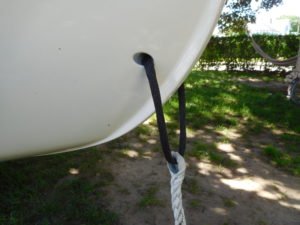Of all the benefits of warm weather, being able to work outside is one of the finest—having the dinghy twenty feet from my front door really sped up the process of getting it done. Not only did it no longer take 45 minutes of driving ‘round trip to get to it and back, but all my tools were in one place: no need to gather everything up each time only to forget a critical bit and have to go back or change plans. Sure, it’s all stuffed into two tiny garage units that have become proper midshipmen’s lockers: everything on top and nothing handy—but that’s just one inconvenience traded for another.

The last picture of the previous post shows a coat of 545 primer going on the outside. After that I left the hull alone for a spell in order to work on the gunwales and interior. Because the inward-oriented gunwale had so far only been attached to the inside of the hull, I wanted to tie it to the outside with one last layer of carbon, which would make a nice transition and smooth radius between hull and “inwale.”

Working outside like this was kind of like when I built Ganymede, all those years ago, in the side yard in California under a spreading oak tree. A pleasant shade, fresh, gentle breezes blowing by, and, just like before, all sorts of leaves and bugs dropping out of the tree onto my work. Well, that’s the lot of the backyard boatbuilder.

With the inwales on and the foredeck in, I had one last detail to attend to before paint. Rather than bolting an eye through the stem for the painter, I cut a hole straight ‘thwartships just behind the stempiece, glued a thick piece of fiberglass tube through, and tabbed it on with carbon scraps. That gave an eye of sorts through which I spliced a dyneema strop for the painter attachment, eliminating the need for a heavy metal bow eye, and bolts and caulk and backing plates. It’s also a prototype for bobstay attachments on future sailboats I plan to build—but let’s not get too far ahead.

All that remained was a week or so of priming, very light fairing, more priming, and topcoating with the same color of Awlgrip I used on Ganymede. On the inside I also put nonskid, not only to hide minor imperfections, but to make the dinghy safe for leaping into on damp days. While on close scrutiny the paint job looks exactly what it is: hand-rolled outdoors in the breeze with leaves and critters dropping by to say hello, it’s still far more gorgeous than the original Woggs.

For the first time ever, I invested in a proper gunnel guard. After years of fooling around with pipe insulation and old fire hose, I’m trying out the special-made, proper-shaped commercial dinghy bumper. At $8 a foot, it comes in rather pricey, but it looks good, and if it lasts it’ll be worth it. Rather than bolting or screwing it on, I lashed it laboriously with dyneema thread. Not so much to keep weight down, but to avoid bolt or screw ends poking in right where hands will be picking it up.

Our first trial run on it was done at a local beach, where one of my rigging-business clients has his boat on a mooring. It doesn’t row any differently from the old dinghy, aside from feeling stiffer along the gunnels, but boy is it easy to pick up and carry! It seems to only weigh a third of what the old one did, and is absolutely no struggle for two people to lift onto the roof racks of the car. We can even flip it easily without putting it down, which was completely impossible with the last one. And so Ganymede’s ideal tender is reborn: stronger, lighter, stiffer, fairer—and with the mold buried somewhere in my midshipmen’s locker of a garage, I can make another in future if need arises or fancy strikes. It’s a comforting thought.